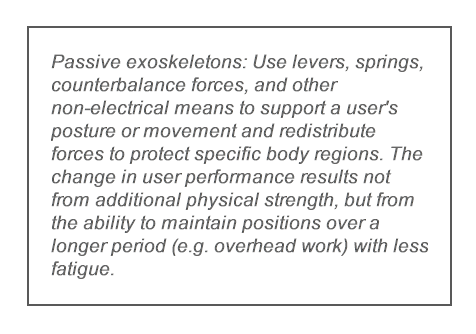Ergonomics Support for Change Management: Integration of Exoskeleton
Written by: Amii Pereira, CCPE, Managing Ergonomist

Ergonomists play a crucial role in supporting client productivity and preventing injuries. To do this effectively, it’s important to explore new trends, and current and emerging technologies, such as exoskeleton, to develop strategies and identify the tools that can best support clients with complex ergonomic risk needs.
Many studies suggest that the use of upper body exoskeleton technologies help to prevent musculoskeletal disorders (MSD), as well as shoulder and upper limb fatigue, especially for roles that require overhead work. Yet successful adoption of these supportive technologies by workers in high injury risk areas remains a challenge. Why?
To explore the why and identify gaps in change adoption that can be addressed in future planning, client data including the perceptions and insights of workers that were involved in an attempted implementation of exoskeleton technology within a manufacturing environment, were collected and analyzed. Subjective feedback provided context around the non-physical factors that influence the successful adoption of exoskeleton supports as an MSD prevention control. Armed with key stakeholder feedback, and these new factors to consider, findings were put to the test in a subsequent exoskeleton applications.
Findings:
- Timing of the implementation of change is a key factor: Are you adding this to an existing process or planning to incorporate this change with a new process? Simply adding exoskeleton use to an existing process design may not fully consider all needs for successful integration.
- Successful implementation requires a review of the processes to ensure that the technology effectively supports the demands of existing work processes. Consideration of process changes (i.e. work flow) may be required to support successful adoption. In some cases, process design changes may be needed. Trialing is key!
- Not all exoskeleton technologies are created equal: worker engagement in planning for the change and selection of the style and model is key to identifying an option that they can comfortably use, will best support the work they do, and ensuring successful change adoption.
In short; introducing new technologies as a method of managing MSDs can beneficial. However, successful adoption really requires practitioners to consider, and plan to mitigate the human factors that influence the ability to accept change.
Feel free to contact us to discuss how we can help you successfully implement use of new technologies and enhance your ergonomics program.
Reference:
www.ccohs.ca/oshanswers/safety_haz/exoskeletons.htmlContact Us Back to Articles
